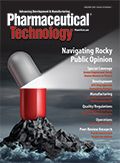Can Policy Keep Pace with Science and Discoveries?
The promise of new therapies is tempered by the need for affordability, safety, and ethics.
Researchers continue to report exciting new discoveries in science and medicine that have the potential to improve life and address challenges facing society. The intersection of scientific opportunity and business profitability can, however, lead to ethical conflicts.
Emerging scientific methods such as Clustered Regularly Interspaced Short Palindromic Repeats (CRISPR) genome editing technology, which can be used to modify genes in living cells and organisms, offer the promise of correcting genetic mutations to treat genetic causes of disease. Researchers and ethicists generally agree that gene editing methods are suitable for research applications, but not for reproductive purposes.
Concerns about the misuse of gene-editing processes were realized when a scientist in China announced in November 2018 that he used CRISPR techniques to edit the genes in human embryos of twin girls with the intention of protecting them against the human immunodeficiency virus. This controversial work was denounced by scientists worldwide; in December 2019, a court in China sentenced the scientist to three years in prison for working outside the boundaries of scientific and medical ethics.
This experiment illustrates the ethical, safety, and legal issues associated with promising new scientific discoveries, and many unanswered questions associated with their long-term use. FDA has pursued enforcement action against dozens of unapproved therapies and treatments based on emerging sciences. In announcing a permanent injunction against a Florida-based facility for selling adulterated and misbranded cellular products, FDA noted there are many offenders selling unproved stem-cell products, and “These actors are taking advantage of patients, many in vulnerable positions with chronic or terminal diseases, by leveraging the widespread belief in the eventual promise of these products, flouting the statutes and our regulations “(1).
Beyond rooting out fraudulent efforts, FDA and industry experts also recognize the challenges with developing emerging therapies. FDA noted that while stem cell products have potential to improve human health, “… that potential will never be fully realized if careful scientific work and thoughtful clinical investigation supporting the safety and efficacy of these products are not conducted.”
More than 1000 gene- and cell-therapy and other regenerative products are currently in the US clinical trial pipeline, illustrating the need for innovative development, manufacturing, and supply chain procedures and practices to deliver these therapies to patients. In an article in BioPharm International, experts from bioprocessing equipment manufacturers and contract development and manufacturing organizations emphasized that standardized commercial manufacturing platforms and processes are needed to ensure that these therapies can be delivered in a safe, cost-effective manner (2).
Emerging therapies are expected to contribute to the growth in global sales of prescription drugs from an estimated $839 billion in 2019 to $1.18 trillion in 2024, a compound annual growth rate of 6.9%, according to Evaluate Pharma. For the top 100 products by sales, Evaluate Pharma analysts expect biotech product sales to overtake conventional product sales for the first time. In addition, biotech products are forecast to represent 32% of prescription drug sales by 2024, up from 28% in 2018 (3).
Expensive, emerging therapies are becoming a larger share of the prescription drug market; however, solutions to the affordability question continue to trail rapid advances in science, threatening the success of these products. “The advances in cutting edge science are, for now, outpacing the traditional pricing and reimbursement systems the industry has been built on,” Evaluate Pharma reported. “This disconnect is leaving both patients and payers wondering how accessible these life-altering products will be.”
References
1. N. Sharpless and P. Marks, “Statement on Stem Cell Clinic Permanent Injunction and FDA’s Ongoing Efforts to Protect Patients from Risks Of Unapproved Products,” Press Release, www.FDA.gov (June 25, 2019).
2. R. Peters, “Faster, Better Bioprocessing in 2020,” BioPharm International, 33 (1) 12-14.
3. Evaluate Pharma, World View 2019, Outlook to 2024 (12th edition, June 2019).
Article Details
Pharmaceutical Technology
Vol. 44, No. 1
January 2020
Page: 10
Citation
When referring to this article, please cite it as R. Peters, “Can Policy Keep Pace with Science and Discoveries?"Pharmaceutical Technology 44 (1) 2020.

Drug Solutions Podcast: A Closer Look at mRNA in Oncology and Vaccines
April 30th 2024In this episode fo the Drug Solutions Podcast, etherna’s vice-president of Technology and Innovation, Stefaan De Koker, discusses the merits and challenges of using mRNA as the foundation for therapeutics in oncology as well as for vaccines.
Drug Solutions Podcast: Applying Appropriate Analytics to Drug Development
March 26th 2024In this episode of the Drug Solutions Podcast, Jan Bekker, Vice President of Business Development, Commercial and Technical Operations at BioCina, discusses the latest analytical tools and their applications in the drug development market.